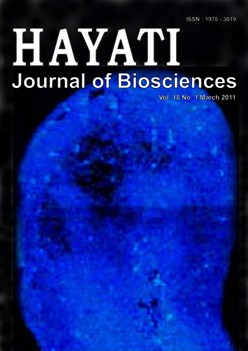<strong><em><span style="font-size:9pt;line-height:115%;">Zingiber cassumunar</span></em><span style="font-size:9pt;line-height:115%;"> Roxb. (<em>Bangle</em>)<em>, Guazuma ulmifolia</em> Lamk.<em> </em>(<em>Jati belanda</em>), and<em> Murraya paniculata </em>(<em>Kemuning</em>)<em> </em>have been used as slimming agents in <em>jamu</em>. A few researches have performed studies on their potency as antiobesity. The aim of this research was to investigate the potency of <em>Z. cassumunar </em>rhizome,<em> G. ulmifolia,</em> and <em>M. paniculata </em>leaf extracts as antiobesity agent based on <em>in vitro</em> inhibition activity of the extracts on pancreatic lipase activity. In this research, water content determination, phytochemical assay, toxicity assay and <em>in vitro </em>assay of inhibition activity on pancreatic lipase were performed toward single and mixture extracts of <em>Z. cassumunar, G. ulmifolia, </em>and<em> M. paniculata</em> resulted by water, ethanol, and saponin extractions<em>.</em> The results indicated that 100 ppm of ethanol extraction of <em>Z. cassumunar </em>had highest inhibition effect on the activity of pancreatic lipase (29.17%), followed by 100 ppm of water extraction of <em>M. paniculata<span> </span></em>(25.66%), 60 ppm of ethanol extraction of <em>G. ulmifolia</em> leaves<em> </em>(25.13%) and ethanol extraction mixture of <em>Z. cassumunar</em>, <em>G. ulmifolia,</em> and <em>M. paniculata </em><span> </span>leaves with ratio of 25:25:25 (21.58%). These inhibition effects were higher than inhibitory effect of 100 ppm of Xenical®/orlistat as the positive control, with the inhibition value of 17.53%. Saponin crude extracts had lower inhibitory effect than the other extractions. It was suggested that ethanol extraction of <em>Z. cassumunar, </em>and <em>G. ulmifolia </em>and<em> </em>water extraction of <em>M. paniculata </em>had potency as antiobesity agent</span></strong>
Abstract
Zingiber cassumunar Roxb. (Bangle), Guazuma ulmifolia Lamk. (Jati belanda), and Murraya paniculata (Kemuning) have been used as slimming agents in jamu. A few researches have performed studies on their potency as antiobesity. The aim of this research was to investigate the potency of Z. cassumunar rhizome, G. ulmifolia, and M. paniculata leaf extracts as antiobesity agent based on in vitro inhibition activity of the extracts on pancreatic lipase activity. In this research, water content determination, phytochemical assay, toxicity assay and in vitro assay of inhibition activity on pancreatic lipase were performed toward single and mixture extracts of Z. cassumunar, G. ulmifolia, and M. paniculata resulted by water, ethanol, and saponin extractions. The results indicated that 100 ppm of ethanol extraction of Z. cassumunar had highest inhibition effect on the activity of pancreatic lipase (29.17%), followed by 100 ppm of water extraction of M. paniculata (25.66%), 60 ppm of ethanol extraction of G. ulmifolia leaves (25.13%) and ethanol extraction mixture of Z. cassumunar, G. ulmifolia, and M. paniculata leaves with ratio of 25:25:25 (21.58%). These inhibition effects were higher than inhibitory effect of 100 ppm of Xenical®/orlistat as the positive control, with the inhibition value of 17.53%. Saponin crude extracts had lower inhibitory effect than the other extractions. It was suggested that ethanol extraction of Z. cassumunar, and G. ulmifolia and water extraction of M. paniculata had potency as antiobesity agentDownloads
HAYATI J Biosci is an open access journal and the article's license is CC-BY-NC. This license lets others distribute, remix, tweak, and build upon author's work, as long as they credit the original creation. Authors retain copyright and grant the journal/publisher non exclusive publishing rights with the work simultaneously licensed under a https://creativecommons.org/

























.png) IPB University
IPB University Department of Biology
Department of Biology The Indonesian Biological Society
The Indonesian Biological Society 

